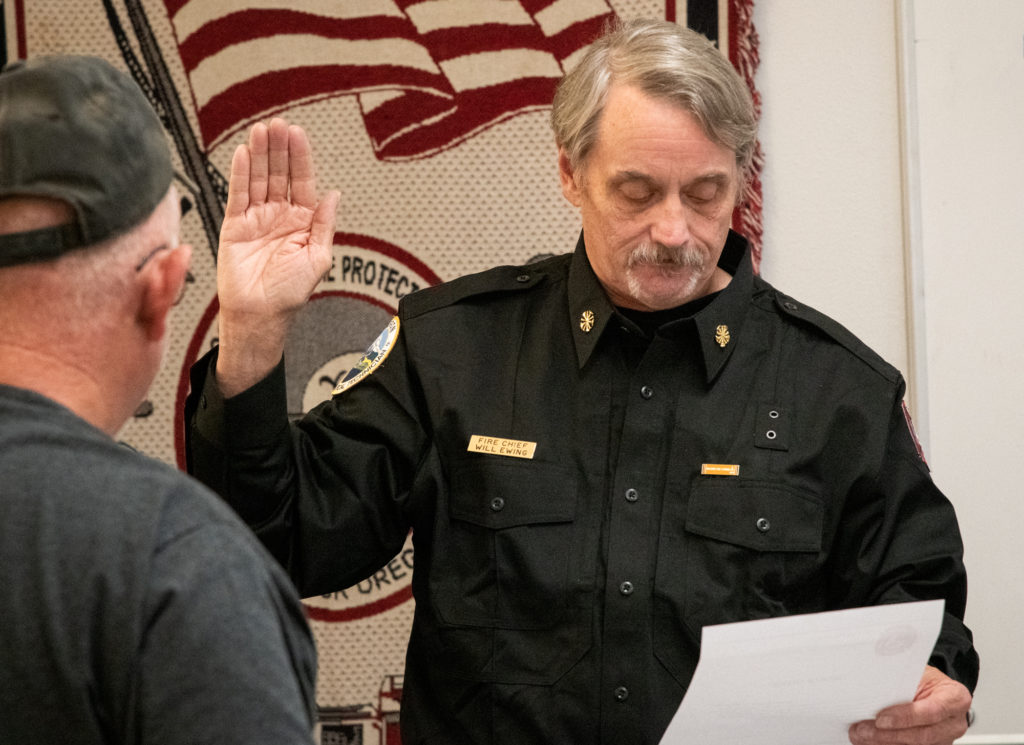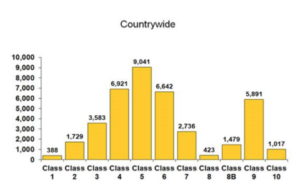
By JORDAN ESSOE/YachatsNews.com
SEAL ROCK – Any homeowners in the Seal Rock Fire District who may have seen a steep increase in their insurance policies shouldn’t blame a newly re-evaluated fire safety rating, the district’s new chief and board members say.
A Facebook post in a community group this month stirred talk that possible mismanagement of the Seal Rock Fire Department caused a fire safety rating by the Insurance Services Office to rise to a 10, the worst possible score.
A new ISO rating for Seal Rock went into effect in February. But the score was calculated on data collected a year ago, not under the current leadership. Notably, the fire safety rating improved from a split rating of 4/4Y/10 to a 4/10 – the same as the neighboring Central Oregon Coast Fire & Rescue. The Yachats Rural Fire Protection District has a 4/4Y/10 rating.
The change in Seal Rock’s rating was the removal of the 4Y classification. Any homes previously classified as 4Y will now be classified as 4, which is a better rating that could potentially decrease a resident’s home insurance premium.
The 4Y classification was removed because the fire department was able to demonstrate its ability to haul water and diminish neighborhood requirements on hydrants.

ISO ratings are not typically made public, but some local fire departments are sharing them to partially reflect how they are performing.
A high ISO rating indicates to insurance companies that a home is more likely to be damaged by fire – and therefore they charge policyholders more to offset the liability. In some cases they will not even offer coverage to people who live in areas with an ISO score of 10.
But a split rating that contains a 10 is not the same as a rating of 10.
The insurance service issues split ratings for fire districts where most homes meet fire safety standards, but one portion of the area does not. While ISO criteria is complex, the biggest determinant is whether a house is within five road miles of a recognized fire station.
Will Ewing, who was sworn in as the new Seal Rock fire chief last week, addressed the issue several times during the monthly board meeting last Thursday.
“Anything east of – I’m going to say South Beaver Creek Road – is going to have a higher rating because they’re not anywhere near the fire station,” Ewing said. “That’s not our doing. It’s all ISO.”
Homes in the Seal Rock district that are within five road miles of either the Bayshore or Seal Rock stations have an ISO rating of 4 – a good rating. Homes located farther than five road miles from a fire station have a poor ISO rating of 10.
The five-mile rule hasn’t changed, although a customer’s insurance company may annually reevaluate the distance it estimates any given property to be from a fire station. Ewing theorizes that insurance companies looking to recoup costs from the expensive 2020 fire season may be stricter with customers.
“If we wanted to reduce the classification on the eastern fringe, you’d have to put a fire station out there and put vehicles in there,” said Ewing. “It would cost half a million to a million bucks to do that.”
It is also important to know the overall assessment of a fire department is only responsible for 50 percent of an ISO rating. Water supply and location of hydrants is responsible for another 40 percent, and the balance is determined largely by the overall quality of emergency communications and dispatch.
Rates on the rise most everywhere
Nationally, home insurance rates are going up for other reasons, primarily the continued rise of property values and the dramatic increase in the cost of construction materials, which drives up the cost to repair or rebuild. Even policyholders who haven’t filed a claim recently and live in a community with a good ISO score can still see an increase in their insurance premiums.
The Insurance Services Office will conduct a new survey when it feels a rating change is needed. In Seal Rock’s case, the future of an intergovernmental agreement between it and the Central Coast fire district could have an impact.
ISO did its most recent survey last spring at the request of COCF&R, which wanted new equipment and facility upgrades taken into account. The Seal Rock district was resurveyed simultaneously because of the previously close relationship between the two departments, and may have benefited from the greater access it had to COCF&R’s equipment and staff under their intergovernmental agreement.
Ewing told YachatsNews he recently conferred with ISO regarding staffing changes he is making within the department – moving from four to two paid firefighters and supplementing them with temporary help and volunteers.
“There would be no negative change right now if they came in and rated us,” Ewing said.
An attempted renegotiation of the intergovernmental agreement between the two districts has been put on hold until an attempted recall of two COCF&R board members plays out.
Acknowledging that uncertainty, Seal Rock board chair Karl Kowalski moved that the agreement with COCF&R be extended through Aug. 31. Board member Paul Rimola said he would only support that extension if it was limited to a master IGA, not an amended one. With that, the motion passed unanimously.
The extension is contingent on the COCF&R board’s agreement.

In other business Thursday, the board appointed David Pelligrinelli, the president of Active Intel Investigations, a private investigative agency based in Florida, to the board. Pelligrinelli fills the seat previously held by Tina Fritz, who resigned in March, and returns the board to five members.
“Why the hell would you want to do this?” joked board member “Skip” Smith.
For his first vote, Pelligrinelli helped unanimously approve a new supplemental budget to adjust revenue and expenditures, with a proposed total increase of $68,462.
- Jordan Essoe is a Waldport-based freelance writer who can be reached at alseajournal@gmail.com


